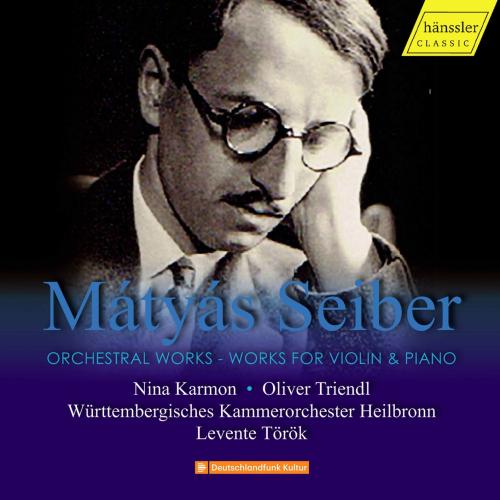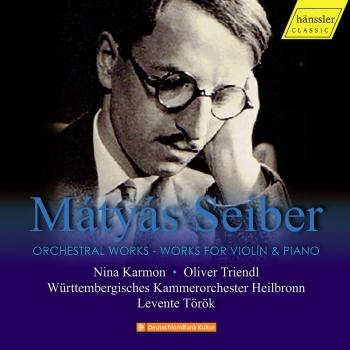
Album info
Album-Release:
2021
HRA-Release:
09.11.2021
Label: haenssler CLASSIC
Genre: Classical
Subgenre: Concertos
Artist: Nina Karmon, Oliver Triendl, Württembergisches Kammerorchester Heilbronn & Levente Török
Composer: Matyas Gyorgy Seiber (1905-1960)
Album including Album cover Booklet (PDF)
- Mátyás Seiber (1905 - 1960): Sinfonietta for String Orchestra:
- 1 Seiber: Sinfonietta for String Orchestra: I. Maestoso - Allegro moderato 07:11
- 2 Seiber: Sinfonietta for String Orchestra: II. Lento 07:12
- 3 Seiber: Sinfonietta for String Orchestra: III. Rondo. Allegro 03:20
- Besardo Suite No. 2:
- 4 Seiber: Besardo Suite No. 2: I. Intrada 01:11
- 5 Seiber: Besardo Suite No. 2: II. Guillemette - Chorea rustica 02:04
- 6 Seiber: Besardo Suite No. 2: III. Gaillarda dolorata 03:04
- 7 Seiber: Besardo Suite No. 2: IV. Branle commun 01:52
- 8 Seiber: Besardo Suite No. 2: V. Madrigale 02:09
- 9 Seiber: Besardo Suite No. 2: VI. Courante de guerre - Canaries 03:16
- Mátyás Seiber:
- 10 Seiber: Fantasia concertante 16:56
- Violin Sonata:
- 11 Seiber: Violin Sonata: I. Appassionato e rapsodico 06:33
- 12 Seiber: Violin Sonata: II. Grazioso, danzata 04:27
- 13 Seiber: Violin Sonata: III. Lento e rubato 05:57
- Mátyás Seiber:
- 14 Seiber: Concert Piece 08:07
Info for Seiber: Works
The friendship between Mátyás Seiber and Antal Doráti dates back to their youth, when they were the two youngest students in Zoltán Kodály's composition class in Budapest in the 1920s. Doráti was one year younger than Seiber and held him in high esteem from the beginning. In the memoirs, Így láttuk Kodályt [‘Thus We Saw Kodály’], he writes the following: "The two 'best' were Mátyás Seiber and Lajos Bárdos. Matyi [Mátyás] wrote a great string quartet at the time, which has survived. One of our tasks was to write variations on a Handel theme. In response to one of Seiber's slow-tempo variations, Mr Kodály said: 'That's nice'. In our eyes - at least in my eyes - that was the canonization of Matyi".
Nina Karmon, violin
Oliver Triendl, piano
Württembergisches Kammerorchester Heilbronn
Levente Török, conductor
Nina Karmon
described by the Frankfurter Allgemeine Zeitung as a "well-grounded and deep artistic fighter with a beautiful sound", is an international soloist. Performances have brought her onto major concert stages like the Tonhalle in Zurich, the Konzerthaus in Vienna, the Gewandhaus in Leipzig, the Konzerthaus in Berlin, the Staatsoper in Munich, the Liederhalle in Stuttgart, the Harmonie in Heilbronn, the Atheneum in Bucharest, the Victoria Concert Hall in Singapore, the Yokohama Minato Mirai Hall in Japan, the Seoul Arts Center in Korea among others.
Nina Karmon performed as a soloist with well known orchestras such as the Orchestra of the Bavarian State Opera in Munich, the Radio Symphony Orchestra in Stuttgart, the Norwegian Radio Orchestra of Oslo, the Stuttgart Philharmonic, the Bucarest Philharmonic, the Filarmonica Banatul Timisoara, the Symphony Orchestra Heilbronn, the Viennese Chamber Orchestra, the Stuttgart Chamber Orchestra, the Wuerttemberg Chamber Orchestra of Heilbronn, the Georgian Chamber Orchestra Ingolstadt, the Nuremberg Symphony Orchestra at the "Classic Open Air" concert in Nuremberg, which was attended by seventy-thousand people, the Korean Chamber Ensemble, the Manhattan Chamber Sinfonia, the Ostrobothnian Chamber Orchestra among others, under the baton of Zubin Mehta, Pinchas Zukerman, Ruben Gazarian, Evan Alexis Christ, Helmuth Rilling, Bernhard Güller, Gabriel Feltz, Christian Simonis, Jörg Faerber, Peter Braschkat, Igor Shukow, Ari Rasilainen, Juha Kangas, Emil Simon, Horia Andreescu, Romeo Rimbu and Gottfried Rabl and others.
Greatly enriching and inspiring has also been her recent collaboration with famous pianist Gerhard Oppitz.
As a devoted chamber musician, Ms. Karmon has worked with artists such as Peter Bruns, Corey Cerovsek, Amaury Coeytaux, Juan Jose Chuquisengo, Olivier Doise, Terhi Dostal, Jurek Dybał, Niklas Eppinger, Ismo Eskelinen, Bengt Forsberg, David Frühwirth, Patrick Gallois, Roland Glassl, Giovanni Gnocchi, Justus Grimm, Michèle Gurdal, Alexander Hülshoff, Thorsten Johanns, Hervé Joulain, Benedict Klöckner, Elisabeth Kufferath, Roland Krüger, Victor Julien-Laferrière, Trey Lee, Michel Lethiec, Jack Liebeck, Lilli Maijala, Diyang Mei, Vladimir Mendelssohn, Laura Mikkola, Floris Mijnders, Béatrice Muthelet, Lena Neudauer, Arto Noras, Denis Omerovic, Bruno Pasquier, Régis Pasquier, Natalia Prishepenko, Rachel Roberts, Hartmut Rohde, Martti Rousi, Pauline Sachse, Guido Schiefen, Stefan Schilli, Hariolf Schlichtig, Niklas Schmidt, Henri Sigfridsson, Alexander Sitkovetsky, Maria Sofianska, Nina Tichman, Oliver Triendl, Gunars Upatnieks, Andreas Willwohl, Wen Sinn Yang and Wen Xiao Zheng and many others.
She has also been heard at the Kuhmo Festival, the Iitti Festival and the Karjalohja Festival in Finland, the Pablo Casals Festival in Prades, the Muskoka Lakes Festival in Canada, the Mainly Mozart Festival in Coral Gables, Florida, the Ludwigsburger Schlossfestspiele, the Hohenloher Kultursommer, the Oberstdorfer Musiksommer, Classix Kempten, the Mozartiade and the Mosel Festwochen in Germany.
In December 2020 a CD with chamber music works by French composer Théodore Dubois has been released on the cpo label.
Other recordings include piano quartets by Finnish composers Ilmari Hannikainen und Helvi Leiviskä, released by Telos Music Records. Sonatas for piano and violin by Ludwig van Beethoven, Johannes Brahms, Richard Strauss, Erwin Schulhoff and Toivo Kuula; Franz Schubert’s fantasy in C and the Groteske for violin and piano by the German composer Rudi Stefan, whose career was abruptly ended at the age of twenty-eight in World War I, the horn trio by the Hungarian composer György Ligetias well as the piano quartet and piano quintet with double bass by Josef Labor. Astor Piazzolla's Histoire du Tango for violin and guitar is available on iTunes.
In 2008, Nina Karmon started the International-Chamber-Music-Festival at Schaubeck Castle in Steinheim. Every year in spring, internationally known musicians come together in the castle’s charming barn to make music.
When she was five years old, Nina Karmon, born in Stuttgart, started to learn cello with her mother, a Finnish cellist. Shortly before her seventh birthday she took up the violin and in the years following she was taught by her father, who at the time was concertmaster of the Stuttgart Radio Symphony Orchestra. After further studies with Silvia Markovici, Vladimir Landsman, Radu Bozgan, and at the Hans- Eisler University in Berlin with Prof. Werner Scholz, she went to New York City for three years as a student of Pinchas Zukerman and Patinka Kopec at the Manhattan School of Music. After this time she returned to Europe.
Booklet for Seiber: Works










